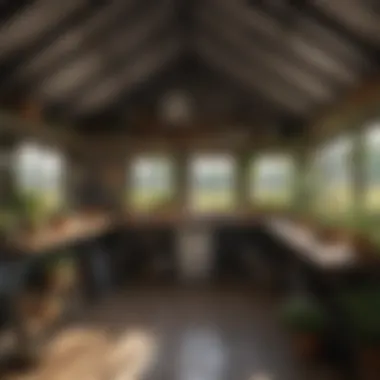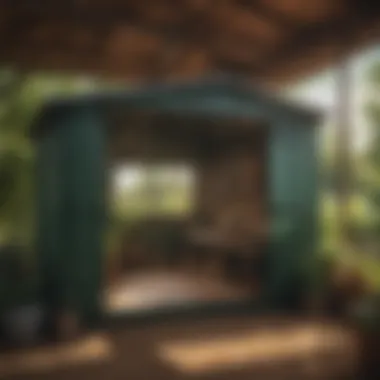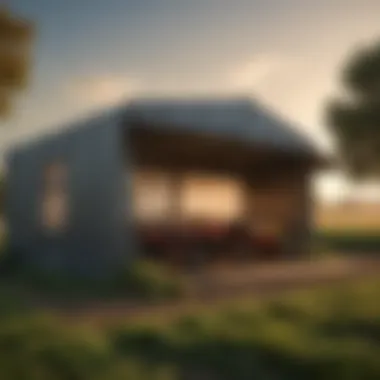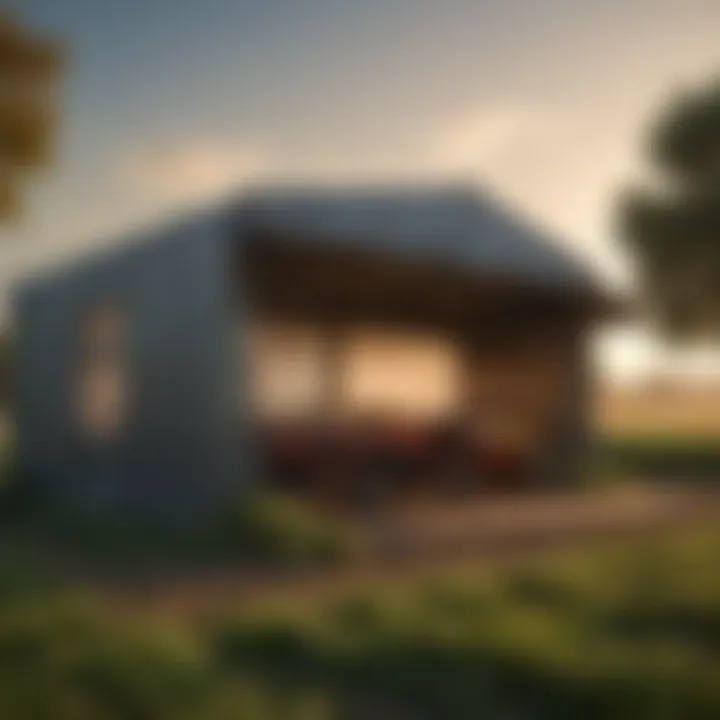Exploring the Versatility of Pop Up Sheds in Agriculture


Intro
The agricultural landscape is changing, and with it, the tools and structures that support it. Pop up sheds stand out as a versatile solution, seamlessly integrating into various farming practices. These structures are engineered for convenience and adaptability, addressing the changing needs of modern agriculture. As farms expand and agrarian practices evolve, understanding the role of these sheds becomes essential for farmers looking to innovate.
Topic Overview
Definition and Importance
Pop up sheds are temporary or semi-permanent structures designed to provide shelter for tools, equipment, livestock, and crops. Their key strength lies in their ability to be assembled and disassembled with ease. This capability allows farmers to modify their workspace in response to specific requirements or changing weather conditions. Importantly, they contribute to efficiency, enhancing productivity while also being cost-effective.
Brief History and Evolution
The concept of temporary structures in agriculture isn't new. However, modern pop up sheds have drawn from various advancements in material science and design technology. Early versions relied heavily on wood and canvas, providing limited functionality. Today, sheds are crafted using durable materials like galvanized steel and weather-resistant fabrics, allowing them to withstand diverse environmental challenges. Their evolution reflects a broader trend towards flexibility and innovation in agricultural methods.
"Pop up sheds symbolize a shift towards more efficient and adaptable farming practices."
Key Techniques and Innovations
Sustainable Farming Practices
Pop up sheds contribute to sustainability by providing flexible options for organic and resource-efficient farming. Farmers can use these structures for crop storage, equipment protection, or as temporary shelter for animals. By promoting better management of resources, these sheds can reduce waste and enhance productivity without significant investment.
Advanced Agronomic Technologies
Technological advancements have ushered in a new era for agriculture, making pop up sheds essential for integrating advanced practices. These structures can incorporate solar panels for energy, alongside smart irrigation systems for crops stored within. As technology develops, the adaptability of pop up sheds ensures they remain relevant for future farming needs.
Practical Applications
Step-by-Step Guides
Farmers interested in implementing pop up sheds can follow these simple steps:
- Assess the Need: Identify what you require the shed for (storage, livestock, etc.).
- Determine Location: Choose an optimal site that provides accessibility and complies with local regulations.
- Select Material: Based on local weather conditions, choose a robust material for longevity.
- Assembly: Follow the manufacturer's instructions to set up the shed efficiently.
- Utilization: Once assembled, maximize its functionality to improve agricultural output.
Case Studies or Real-World Examples
Several farms globally have adopted pop up sheds into their operations. For instance, a farm in California utilized a pop up shed to protect cash crops during the rainy season. By setting these sheds up smartly, they managed to prevent crop waterlogging, maintaining their yield and income. Similarly, a livestock farm in Texas reported improved animal health by providing shelter from extreme weather, ensuring higher survival rates.
In summary, pop up sheds are a valuable addition to modern agriculture. Their design, functionality, and adaptability make them suitable for various applications. Educating farmers on these tools' potential is essential for maximizing their benefits and addressing the ever-changing challenges of agriculture.
Intro to Pop Up Sheds
Pop up sheds have become a significant topic in the agricultural sector due to their versatility and convenience. In modern agriculture, where efficiency is key, these structures fulfill a variety of needs for farmers and agricultural enthusiasts alike. The importance of pop up sheds lies not only in their design and functionality but also in the ways they adapt to different farming environments and practices. This section will explore what makes pop up sheds a valuable asset in contemporary agriculture.
Defining Pop Up Sheds
A pop up shed is a temporary structure that can be easily assembled and disassembled. They are often made from lightweight materials, which makes transportation and storage convenient. These sheds serve multiple purposes, including protecting tools, storing equipment, or offering shelter for animals. They are not permanent buildings but can provide numerous practical applications for farmers who need flexible solutions in their operations.
The core feature of pop up sheds is their portability. Farmers can quickly set them up in various locations, depending on their specific requirements at any given time. This adaptability not only saves time but also reduces the financial burden associated with traditional, permanent structures. Their varied design options allow users to select a model that suits their specific needs, reinforcing their role as a practical solution in agriculture.
Historical Context
Understanding the historical context of pop up sheds helps grasp their emergence in agriculture. Traditionally, farmers relied on fixed structures that limited their mobility and adaptation to changing circumstances. However, as agricultural practices evolved and the need for efficiency increased, the concept of temporary, movable shelters began to gain traction.


The development of lightweight materials and newer construction techniques has significantly influenced the popularity of pop up sheds. Innovations have allowed these structures to become more durable and weather-resistant, which has expanded their usability across a variety of climatic conditions. Over the decades, farmers have recognized the importance of flexibility in their operations, leading to a growing acceptance and integration of pop up sheds into modern agricultural practice.
In summary, as agriculture continues to adapt to a dynamic environment, pop up sheds offer a unique solution. Their ability to meet instantaneous needs and enhance operational efficiency will likely keep them at the forefront of farming strategies for the foreseeable future.
"Pop up sheds are not just a trend; they reflect the changing needs of the agricultural community and illustrate the push for more adaptive farming strategies."
Structural Characteristics
Understanding the structural characteristics of pop up sheds is paramount for anyone engaged in modern agriculture. These traits determine their usability, longevity, and overall effectiveness in various agricultural contexts. For farmers and agricultural enthusiasts, knowing these details not only influences purchasing decisions but also shapes the way these structures are incorporated into operational practices.
Materials Used
The choice of materials significantly impacts the performance and suitability of pop up sheds. Typically, they are made from a range of materials, each offering distinct advantages:
- Metal: Galvanized steel is a common choice for frames due to its strength and resistance to corrosion. Metal structures often withstand harsh weather conditions better than others.
- Fabric: High-density polyethylene or polyester fabrics are popular for the covers. These materials are lightweight yet durable, helping in maintaining airflow while providing protection from UV rays.
- Plastic: Some manufacturers utilize reinforced plastic, providing a waterproof option that is also relatively easy to clean.
- Wood: In some cases, wood is used, particularly for aesthetic purposes, but it generally requires more maintenance compared to metal or fabric sheds.
Farmers must evaluate the local climate and specific needs to choose the right materials. Durability and weather resistance directly influence the overall return on investment.
Design Configurations
The design configurations of pop up sheds are crucial for their functional application. There are several styles and setups, each targeting specific agricultural needs:
- A-Frame: This design is efficient for rain and snow runoff, reducing the risk of damage during heavy storms.
- Tent Style: Often utilized in temporary setups, these are easy to assemble and disassemble. They are ideal for farmers who require on-the-go structures that are flexible in location.
- Modular Constructs: Some sheds are designed for easy expansion. Farmers can add sections more as needs increase without replacing the entire structure.
The design must also allow for appropriate ventilation. Proper airflow helps in temperature regulation, particularly in storage applications. The consideration of entry points and layout is vital to ensure ease of use for various agricultural tasks, such as accessing equipment or storing crops.
"Choosing the right materials and configurations enhances the functionality of pop up sheds and aligns them with the practical needs of modern farming."
In summary, the structural characteristics provide insight not only into the integrity and ability of pop up sheds to perform but also into the adaptability necessary for changing agricultural demands. Each element, from materials to designs, plays a pivotal role in determining how effectively these structures serve their purpose in today's farming environments.
Applications in Agriculture
Pop up sheds have emerged as a strategic asset for modern agricultural practices. Their ability to adapt to diverse farming environments speaks to their importance. From seasonal storage to instant workspaces, these structures cater to various needs. Farmers increasingly rely on them for their versatility and practicality.
Storage Solutions
Storage is critical in agriculture. Farmers often require space for tools, equipment, and harvested produce. Pop up sheds provide an immediate solution for this. Their ease of assembly allows farmers to create additional storage whenever needed.
- Temporary Storage: Use during peak harvest times.
- Protection from Elements: Shields equipment from rain, wind, and sun.
Farmers can modify the interior space based on what they store. For instance, adding shelves or hooks can enhance storage efficiency. Large items can simply be parked inside. This flexibility ensures that no matter the situation, the farmer has access to their essential tools and supplies.
Temporary Workspaces
Workspaces are necessary for various tasks in farming. Whether it's repairing machinery or sorting produce, pop up sheds offer practical temporary work environments. They are easily set up, allowing farmers to create a working area close to their field or operation.
- Convenience: Can be located where work is happening.
- Cost-effective: Reduces the need for permanent facilities.
Additionally, these sheds can be equipped with tables, chairs, or power sources for greater functionality. Their temporary nature means they can be dismantled and stored when not in use, which saves space and resources.
Field Operations
In-field operations often require temporary setups. Pop up sheds are ideal for this purpose, allowing farmers to maintain operations in varied field conditions. They can serve as portable kiosks for selling produce or as bases for crews working a certain area.
- Enhanced Mobility: Facilitate moving operations as needed.
- Adaptability: Suitable for different types of farming or events.


These benefits make pop up sheds invaluable during the busy agricultural season. Their versatility is not just confined to storage and workspaces; they also enable farmers to respond rapidly to changing needs, providing a dynamic solution to modern agricultural challenges.
Benefits of Pop Up Sheds
Pop up sheds present numerous advantages that can significantly enhance agricultural operations. These structures serve as essential tools for farmers looking to optimize their resources and adapt to the modern demands of agriculture. The benefits range from economic savings to practical features that accommodate various farming needs. Understanding these benefits is vital for making informed decisions about utilizing pop-up sheds in agricultural settings.
Cost-Effectiveness
One of the key advantages of pop up sheds lies in their cost-effectiveness. Traditional permanent structures often require substantial investment, including materials, labor, and maintenance. In contrast, pop up sheds are usually made from less expensive materials and can be erected quickly. This can drastically reduce initial setup costs.
Farmers can save on labor costs as well, since the installation of these sheds is typically less labor-intensive. The ability to use pop up sheds for short durations allows farmers to avoid long-term financial commitments while still achieving essential storage or workspace functionalities. This flexibility can be especially valuable during peak seasons when temporary needs arise, thus maximizing overall operational efficiency.
Mobility and Flexibility
Mobility is another significant benefit of pop up sheds. Their design allows for easy relocation, enabling farmers to adapt to changing conditions. Whether responding to crop rotations or shifting market demands, the ability to reposition these structures offers unparalleled flexibility. Farmers can move the sheds closer to fields or areas where they are needed most, reducing downtime and improving productivity.
Additionally, the modular nature of pop up sheds means that farmers can adjust the size and configuration based on specific requirements. This can be particularly useful for different activities, such as storing equipment or creating temporary workspace for seasonal labor. Overall, the mobility and flexibility of pop up sheds allow farmers to operate more efficiently, aligning their resources with their operational needs.
Rapid Setup and Teardown
The quick setup and teardown of pop up sheds is another factor that enhances their value in agriculture. Unlike traditional buildings, which can take weeks or even months to construct, pop-up sheds can often be assembled in a matter of hours. This time efficiency enables farmers to react promptly to sudden needs, such as unexpected weather or urgent harvesting tasks.
Furthermore, the ease of disassembly means that these structures can be stored when not in use, reducing clutter on agricultural land. This can be particularly beneficial for farmers with limited space. For instance, if a farmer encounters unfavorable weather conditions, they can quickly dismantle the shed to prevent damage and then easily reassemble it once conditions improve.
"The ability to swiftly adapt structures in agriculture can lead to better management of resources and a more sustainable approach to farming."
In summary, the benefits of pop up sheds—cost-effectiveness, mobility, and rapid setup—highlight their importance in modern agriculture. Harnessing these advantages can contribute to more efficient farming practices, ultimately leading to improved productivity and profitability.
Challenges and Considerations
As the use of pop up sheds grows among modern farmers, addressing the challenges and considerations surrounding these structures is crucial. Understanding these elements helps farmers make informed decisions. This section covers three important aspects: weather resistance, durability issues, and regulatory compliance.
Weather Resistance
Weather resistance is a primary concern for any temporary structure used in agriculture. Pop up sheds must withstand varying climates. Heavy rains, snow, wind, or extreme heat can affect the integrity of the shed. Farmers need to select sheds designed with weather-resistant materials. Options like reinforced vinyl or high-density polyethylene offer better protection against the elements.
When purchasing, it’s wise to ask about weather ratings and performance in adverse conditions. A well-made pop up shed should keep its contents dry and maintain stability during storms. Failing to address weather resistance can lead to damage and increased costs for repairs or replacements.
"The right pop up shed can be an asset in any weather situation, but neglecting this aspect can turn it into a liability."
Durability Issues
Durability is another vital consideration for farmers. Pop up sheds face wear and tear from regular use. The materials and construction quality directly impact how well a shed will hold up over time. Many farmers find that lower-cost options do not endure as well as expected.
Common problems include:
- Tear and wear from movement or resistance to wind.
- Oxidation or fading due to UV exposure.
- Structural failure from poor assembly or material quality.
Before investing in a pop up shed, farmers should research and choose models that emphasize long-term durability. Some brands test their products against specific conditions, providing peace of mind.
Regulatory Compliance
Regulatory compliance is essential for agricultural structures, including pop up sheds. Each region has specific laws governing their use. These regulations can pertain to safety, zoning, and construction standards. Failing to comply with local laws can result in fines and the need to remove the structure.
Farmers must check local ordinances before setting up a pop up shed. It is often beneficial to consult with local agricultural extensions or legal experts to ensure compliance. Understanding the regulations protects investments and prevents future complications.


Sustainability Aspects
Sustainability is a vital consideration in modern agriculture, especially when examining the role of structures like pop up sheds. These sheds not only serve functional purposes but can also contribute significantly to sustainable farming practices. As agriculturalists strive to minimize their ecological footprint, pop up sheds present an opportunity to align agricultural operations with sustainability goals.
Environmental Impact
The environmental impact of agriculture has come under scrutiny as methods traditionally implemented can lead to soil degradation, habitat destruction, and increased greenhouse gas emissions. Pop up sheds are designed with a smaller carbon footprint compared to permanent structures. Their lightweight nature allows for minimal land disruption during setup and teardown. This flexibility minimizes long-term land use effects and allows land to be restored or used for other farming purposes when sheds are not in operation. Additionally, their temporary usage ensures that natural landscapes remain more intact, supporting local ecosystems.
By simplifying logistics in farming, these sheds can also reduce the need for extensive transportation, further lowering emissions associated with moving goods from one point to another. If farmers utilize pop up sheds strategically, they can significantly contribute to a reduction in overall agricultural emissions.
Sustainable Materials
The choice of materials used in the construction of pop up sheds significantly impacts their sustainability. Many manufacturers now focus on sourcing materials that are eco-friendly and replenishable. Examples include bamboo, which is fast-growing and requires minimal resources, and recycled plastics, which repurpose waste materials that would otherwise contribute to environmental damage.
In a world where resource conservation is crucial, investing in pop up sheds constructed from such materials can lead to considerable advancements in sustainable practices. Utilizing renewable resources means the agricultural sector can continue benefiting from technology while lessening its burden on the planet. Furthermore, the inclusion of such materials in pop up shed design helps to cultivate a culture of sustainability within farming communities.
"Investing in sustainable materials not only ensures longevity for pop up sheds but fosters a commitment to environmental responsibility in agriculture."
In summary, the integration of pop up sheds into agricultural practices carries profound implications for sustainability. Their reduced environmental impact and potential for utilizing sustainable materials positions them as a valuable asset in the ongoing pursuit of eco-friendliness in farming.
Future Trends in Pop Up Sheds
As agriculture evolves, so do the tools and structures that support it. Pop up sheds are no exception to this trend. Understanding future developments in their design and functionality is crucial for farmers aiming to stay ahead of the curve. This section examines the shifting landscape of pop up sheds, revealing emerging trends that can shape agricultural practices. Farmers and enthusiasts should take note of how these trends can enhance efficiency and sustainability in their operations.
Technological Innovations
Technological advancements are making significant impacts on the design and utility of pop up sheds. For instance, improved materials are allowing for lighter yet stronger structures, which enhance mobility and durability.
- Advanced Materials: The incorporation of high-performance fabrics and composite materials provides better weather resistance while being easy to transport and set up.
- Smart Features: Some manufacturers are integrating sensors and IoT technologies. This allows farmers to monitor conditions inside the shed, such as temperature and humidity, thus optimizing storage for crops or equipment.
- Energy Solutions: Solar panels are becoming a common feature in pop up sheds, providing a renewable energy source for lighting or climate control systems.
These innovations not only increase the practical applications of pop up sheds but also streamline farming practices.
Integration with Smart Agriculture
The rise of smart agriculture is a game changer for the use of pop up sheds. Farmers are increasingly seeking solutions that align with precision agriculture strategies. Pop up sheds can play a pivotal role in this integration.
- Data Management: By being equipped with connectivity options, pop up sheds can send real-time data to farmers’ devices. This enables better decision-making based on current conditions.
- Flexible Use: These structures can be easily relocated based on the changing needs of farm operations. Smart farmers can adapt the location of these sheds as per crop cycles or seasonal changes, which is a significant advantage.
- Resource Efficiency: Implementing smart technologies in conjunction with pop up sheds improves the management of resources, such as water and energy, ultimately supporting sustainable farming practices.
By integrating pop up sheds into smart agricultural practices, farmers can maximize the potential of their operations.
Culmination and Recommendations
The section on conclusion and recommendations ties together the various insights about pop up sheds in modern agriculture. It is essential to synthesize the key points discussed throughout the article. This helps to reinforce the value these structures provide to farmers. In a rapidly changing agricultural landscape, understanding the role of pop up sheds can guide farmers in making informed decisions regarding their operations.
Assessing Suitability for Specific Needs
Assessment of suitability is a critical factor for farmers considering pop up sheds. Different agricultural contexts may require distinct features. Farmers must evaluate their specific needs regarding space, durability, and purpose. For example, a farmer who requires a temporary workspace for seasonal activities should prioritize rapid setup and mobility. Conversely, a farmer seeking long-term storage solutions might prioritize sturdy materials and larger dimensions. Understanding these specifics helps in choosing the right pop up shed.
- Key considerations:
- Purpose of use (storage, workspace, field operation)
- Ground conditions and climate
- Budget constraints and cost-effectiveness
- Permit and regulatory needs
Future Research Directions
Future research on pop up sheds should focus on several critical areas. Innovations in materials and design could enhance the usability of these structures. For instance, investigating lightweight yet strong materials could make pop up sheds easier to transport. Another important area is the integration of technology. Utilizing sensors or smart systems could help monitor internal conditions and increase efficiency. Researching user experiences will also provide valuable insights. Gathering feedback from farmers can guide future improvements and adaptations.
Future studies can significantly influence how pop up sheds are developed and applied in various farming sectors.
Potential areas of investigation include:
- Sustainable materials development
- Technological enhancements
- User experience evaluations
- Market assessments of demand



